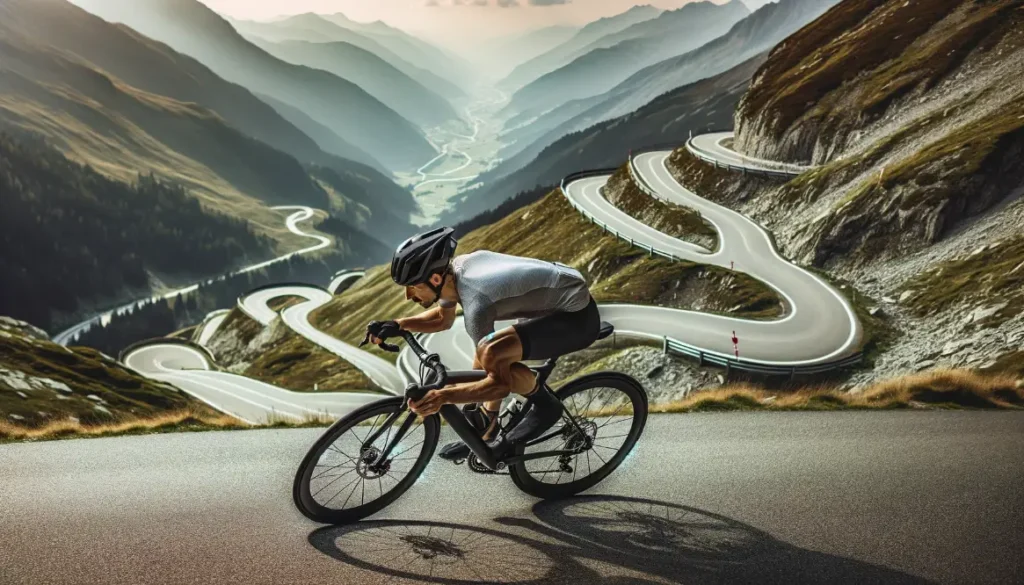
For many cyclists, hills are viewed as the enemy, something to be dreaded and avoided if possible. However, conquering a tough climb can be immensely satisfying. With some strategy, training, and mental preparation, you can become a hill climbing master.
1. Gearing Up for Hills
Having the proper gears is essential for efficient and comfortable hill climbing. Most road bikes now come equipped with compact cranksets (50/34 teeth) versus the traditional 53/39 setup. The smaller chainrings make spinning easier. Pair this with a wide-range cassette (11-32 teeth) and you’ll have all the gears needed to tackle steep grades.
It’s vital to shift before the climb gets too steep. If you wait until your pedaling cadence slows significantly, the sudden jump to an easier gear will be more difficult. Also, avoid cross-chaining—using your largest chainring with the largest rear cogs—which strains the drivetrain.
2. Climbing Technique
There are two main techniques for climbing out of the saddle. Standing allows you to put more body mass over the pedals to generate more power. However, this technique can fatigue the legs quicker.
Sitting uses less energy but typically produces less power. Alternate between the two styles every minute or two to give muscle groups a break.
Pedaling circles versus pedaling squares utilizes smoother, more efficient leg rotations. Squaring the stroke taxes specific muscles more. Focus on spinning perfect circles no matter if you’re sitting or standing.
Proper weight distribution also aids climbing efficiency. Having too much weight over the back wheel can cause wheel slippage. Shift forward enough to keep rear wheel traction.
3. Building Hill Climbing Fitness
Improving your climbing ability requires challenging hill workouts. An excellent way is performing high-intensity interval training (HIIT) on hills. After warming up, sprint up a hill close to max effort, then easy spin back down to recover. Repeat this 8-10 times in a session.
Doing prolonged hill repeats also boosts fitness. Climb a long steady grade hill, descend, then repeat multiple times to increase endurance.
Strength training helps as well. Focus especially on quadriceps, glutes, and core exercises that target muscle groups used in climbing.
4. Fueling Your Climb

Fueling properly before and during a big climb can make the difference between success and blowing up halfway.
For days leading up to a hilly ride, carb load to fill muscle glycogen stores. Then, top off in the final 24 hours. Avoid anything too heavy pre-ride however that may cause GI distress.
Stay hydrated while climbing by taking a sip of sports drink every 5-10 minutes. The carbohydrates and electrolytes will provide energy and prevent cramps.
If tackling an extremely long climb, pack quick energy foods like energy gels, chews, or bars. Take bites while continuing to pedal to avoid bonking.
5. Developing Mental Toughness
Beyond physical fitness, the right mindset is vital for hill climbing success.
Rather than dread a big climb, embrace the challenge as a way to test your limits and build mental fortitude. Feeling intimidated ahead of time increases suffering while climbing.
On long climbs, Monitor your effort carefully and pace yourself properly. Going too hard early leads to rapid burnout. Settle into a sustainable tempo then stick with it.
See also: Elevation Gain in Cycling ⛰️: Conquer the Heights for Ultimate Performance
Negative inner dialogue sabotages performance. Replace it with positive self-talk and words of encouragement. “I can do hard things” or “the suffering is only temporary” reinforce why you are pushing so hard.
6. Safety First
While climbing, it’s critical to remain in control and visible to traffic. Aggressively leaning into turns or sudden movements can cause crashes or collisions.
Control your speed on descents rather than letting momentum carry you at dangerous fast speeds. Cover brakes and be prepared to slow or stop if needed.
Also, make yourself visible by wearing bright clothing, using blinker lights even during daylight, and taking primary road position rather than hugging curbs.
Do a thorough bike check prior to riding—especially brakes and drivetrain—to avoid mechanical issues on steep mountain roads.
7. Descending with Confidence
What goes up must come down. Safely descending hills requires learned skills.
Get in the habit of feathering both brakes rather than grabbing just one. Putting more pressure on the front brake provides greater control without pitching you over the handlebars.
Focus your eyes farther down the road rather than right in front of your wheel. Your line of sight should be 3-5 seconds ahead, giving you time to process and react.
Lean your bike into turns, not your body. This lowers your center of gravity and helps handle tighter turns. Don’t stare down at the road either but keep your head level with the horizon.
With some dedicated practice honing your techniques, you’ll be zipping down the other side after each grueling climb. Mastering both ascents and descents makes you an all-around better cyclist.
Conclusion
Conquering hills on a bike presents both physical and mental hurdles to overcome. However, with the right strategies for fitness, fuelling, gearing, technique and mindset, you can rise to the challenge. Lean into your weaknesses and turn hill climbing into a strength. The panoramic views at the top will be your sweet reward.
FAQs
What is the easiest gear ratio for climbing hills? An easier gear ratio like a 34/32 will make most hills manageable without excess strain. However, incremental gear adjustments allow you stay in optimal pedalling cadence.
What muscles are used most for climbing? Quadriceps are the primary movers during seated climbing. The glutes, core, back and arms are also utilized heavily when climbing out of the saddle standing.
How steep of a hill can the average cyclist climb?
Most amateur cyclists can manage sustained grades of up to 10% before it becomes highly taxing. However elite pros can tackle short bursts exceeding 30%.
Should I stand or sit while hill climbing? There are advantages to both techniques. Generally standing is recommended for steeper short hills under a few minutes where more power and arm involvement is helpful. Sitting is best for longer gradual climbs to conserve energy.
What gear is easiest for descending hills? Use your largest chainring but smaller cogs (11-15 teeth) in back to allow freewheeling at a controlled speed. Quick gear changes on the cassette fine tune velocity. Cover the brakes but don’t drag them continuously.






